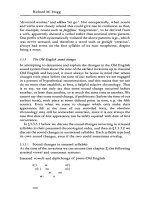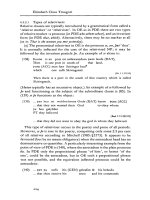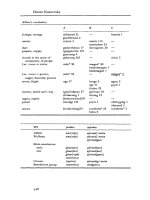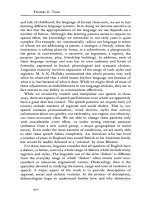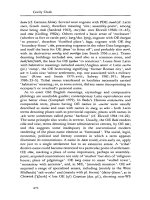The Cambridge History of the English Language Volume 1 Part 1 ppt
Bạn đang xem bản rút gọn của tài liệu. Xem và tải ngay bản đầy đủ của tài liệu tại đây (1.59 MB, 62 trang )
The
Cambridge History
of
the English Language
is
the first multi-
volume
work
to
provide a full account
of
the history
of
English. Its
authoritative coverage extends from areas
of
central linguistic interest
and concern
to
more specialised topics such
as
personal and place
names.
The
volumes dealing with earlier periods are chronologically
based, whilst those dealing with more recent periods are geo-
graphically based, thus reflecting the spread
of
English
over
the last
300 years.
Volume I deals with the history
of
English
up
to
the Norman
Conquest, and contains chapters
on
Indo-European
and Germanic,
phonology and morphology, syntax, semantics and vocabulary,
dialectology, onomastics and literary language. Each chapter,
as
well
as
giving a chronologically-oriented presentation
of
the data, surveys
scholarship in the area and takes full account
of
the impact
of
developing and current linguistic theory
on
the interpretation
of
the
data.
The
chapters have been written with both specialists and non-
specialists in
mind;
they will be essential reading for
all
those
interested in the history
of
English.
THE
CAMBRIDGE
HISTOR
Y
OF
THE
ENGLISH
LANGUAGE
GENERAL
EDITOR
Richard M.
Hogg
VOLUME
I
The
Beginnings
to
1066
Facsimile page from the Exeter Book of Anglo-Saxon poetry
(Exeter D. & C. MS 3501, s. x): The
Wanderer,
76v, lines 1-33.
Reproduced by kind permission of the Dean and Chapter
of Exeter Cathedral.
THE CAMBRIDGE
HISTORY OF THE
ENGLISH LANGUAGE
VOLUME
I
The
Beginnings
to 1066
EDITED
BY
RICHARD M.HOGG
Smith Professor
of
English Language
and
Medieval Literature, University
of
Manchester
|
CAMBRIDGE
UNIVERSITY
PRESS
PUBLISHED
BY
THE
PRESS
SYNDICATE
OF
THE
UNIVERSITY
OF
CAMBRIDGE
The
Pitt Building, Trumpington Street, Cambridge, United Kingdom
CAMBRIDGE
UNIVERSITY
PRESS
The
Edinburgh Building, Cambridge CB2 2RU,
UK
40 West 20rh Street,
New
York,
NY
10011-4211, USA
477 Williamstown Road,
Port
Melbourne, VIC 3207, Australia
Ruiz de Alarcon 13, 28014 Madrid, Spain
Dock
House,
The
Waterfront, Cape Town 8001, Sourh Africa
© Cambridge University Press 1992
This
book
is
in copyright. Subject
to
statutory exception
and to rhe provisions
of
relevant collective licensing agreements,
no
reproduction
of
any
part
may take place wirhout
rhe written permission
of
Cambridge University Press
First published 1992
Sevenrh printing 2005
Printed in rhe United Kingdom at rhe University Press, Cambridge.
A
catalogue
record
for
this
book
is
available
from
the
British
library
li~ryo/u~~u~~~m~MM~nMm
The
Cambridge history
of
rhe English language/edited by Richard M.
Hogg.
p.
cm.
Includes bibliographical references and index.
Contents:
v.
1.
The
beginnings
to
1066
ISBN 0-52l-26474-X
(v.
1)
1.
English language-History.
1.
Hogg, Richard M.
PEI072.C36 1992 91-13881
420'.9-dc20
CIP
ISBN 0
521
26474 X hardback
UP
CONTENTS
List
of
illustrations
page
x
hist
of
contributors
xi
General Editor's
preface
xiii
Acknowledgements
xvii
List
of
abbreviations
xix
Map
of
Anglo-Saxon England xxii
1
INTRODUCTION Richard M.Hogg 1
1.1 Political history and language history 1
1.2 Ecclesiastical history and language history 10
1.3 Literary history and language history 14
1.4 The nature of the evidence 19
Further reading 25
2 THE PLACE OF ENGLISH IN
GERMANIC AND INDO-
EUROPEAN Alfred
Bammesberger
26
2.1 Language change
and
historical linguistics
26
2.2
The
Germanic languages
28
2.3
The
Indo-European languages
31
2.4 Historical phonology
33
2.5 Historical morphology
47
2.6 Syntax
59
2.7
The
lexicon
63
Further reading
66
vn
Contents
3
3.1
3.2
3.3
3.4
4
4.1
4.2
4.3
4.4
4.5
4.6
4.7
5
5.1
5.2
5.3
5.4
5.5
6
6.1
6.2
6.3
6.4
7
7.1
7.2
7.3
PHONOLOGY AND
MORPHOLOGY
Richard
M.
Hogg
Introduction
Orthography
Phonology
Morphology
Further reading
SYNTAX Elizabeth
Closs Traugott
General background
Noun phrases
Verbal groups
Case assignment
and the
status
of
subject
and
object
Complex sentences
Word order
and the
order
of
clauses
Summary
of
changes
Further reading
SEMANTICS AND VOCABULARY
Dieter Kastovskj
Introduction
Foreign influence
The stratification
of
the
Old
English vocabulary
Word-formation
Semantics
Further reading
OLD ENGLISH DIALECTS
Thomas
E.
Toon
Introduction
Old English dialects: origins
and
sources
Orthographic
and
phonological variation
Variation
and
dialectology
Further reading
ONOMASTICS
Cecily Clark
General principles
Anthroponymy
Toponymy
Further reading
67
67
72
83
122
164
168
168
171
179
201
219
273
285
286
290
290
299
338
355
400
407
409
409
414
429
433
451
452
452
456
471
487
Vlll
Contents
8 LITERARY LANGUAGE
Malcolm
R.
Godden
490
8.1 Introduction
490
8.2 Poetry
491
8.3 Prose
513
Further reading
535
Glossary of
linguistic
terms
536
Bibliography
Primary
sources
and texts
548
Secondary sources
550
Index
589
ix
ILLUSTRATIONS
Facsimile page from
the
Exeter Book
of
Anglo-Saxon poetry (Exeter
D.
&
C. MS 3501,
s.
x): The Wanderer, fo. 76v, lines 1-33. Reproduced
by kind permission
of
the Dean and Chapter
of
Exeter Cathedral
frontispiece
Map
of
Anglo-Saxon England. Drawn
by Dr
David Hill
of
the
Department
of
Extra-Mural Studies
at
Manchester University
page xxi
2.1 The Germanic languages
and
their documentation
29
2.2 Schematic representation
of
the linguistic family tree
33
2.3 The consonantal and vocalic phonemes
of
Indo-
European
34
2.4 Schematic representation
of
the consonant shift
in
Pre-
Germanic
38
3.1 Maps
of
pre-650 and post-650 runic monuments (Page
1973)
80
3.2 Futhark from Kylver, Gotland, ca 400 (Page 1973)
81
3.3
Old
English futhorc (Dickins, 1932). Reproduced
by
courtesy
of
heeds Studies in English
1,
from Bruce Dickins,
' A system
of
translation
of
Old English runic
inscriptions'
81
3.4 The development
of
consonants (especially voiced stops
and fricatives) from Germanic
to
Old English
111
4.1 Diagrammatic representation
of
restrictions
on
extraction
called 'island constraints'. Reproduced
by
courtesy
of
Mouton, from Charles
R.
Carlton, Descriptive Syntax of
the
Old English Charters (Mouton, 1970),
p. 177 231
6.1 Map
of
areas
of
rhotacism
412
6.2 New York City
(r) by
class and style (after Labov 1966)
414
6.3 Map
of
early Anglo-Saxon England
419
6.4 The products
of
literacy
in
their political context
425
XI
CONTRIBUTORS
ALFRED BAMMESBERGER
Professor
of
English
Linguistics,
Katholische Universitdt Eichstdtt
CECILY CLARK
Cambridge
MALCOLM GODDEN
Kawlinson and Bosworth Professor of
Anglo-Saxon,
University
of
Oxford
RICHARD M. HOGG Smith
Professor
of
English Language and
Medieval
Literature,
University
of
Manchester
DIETER KASTOVSKY
Professor
of
English
Linguistics,
lnstitut
fur Anglistik
und
Amerikanistik,
Universitdt
Wien
THOMAS E. TOON
Professor
of
Linguistics,
Program
in
Linguistics,
University
of
Michigan,
Ann Arbor
ELIZABETH CLOSS TRAUGOT T
Professor
of
Linguistics,
Department
of
Linguistics,
Stanford University
Xlll
GENERAL EDITOR'S PREFACE
Although
it is a
topic
of
continuing debate, there can
be
little doubt
that English
is the
most widely-spoken language
in the
world, with
significant numbers
of
native speakers
in
almost every major region
—
only South America falling largely outside the net. In such a situation an
understanding
of
the nature
of
English can be claimed unambiguously
to be
of
world-wide importance.
Growing consciousness
of
such
a
role
for
English
is one of the
motivations behind this History. There
are
other motivations
too.
Specialist students have many major and detailed works
of
scholarship
to which they can refer, for example Bruce Mitchell's
Old English
Syntax,
or, from
an
earlier age, Karl Luick's Historische Grammatik der
englischen
Sprache.
Similarly, those who come new
to
the subject have both one-
volume histories such
as
Barbara Strang's History
of
English
and
introductory textbooks
to a
single period,
for
example Bruce Mitchell
and Fred Robinson's
A
Guide
to
Old
English.
But what is lacking is the
intermediate work which can provide a solid discussion of the full range
of
the
history of English both to the anglicist who does not specialise in
the particular area
to
hand
and to the
general linguist
who has no
specialised knowledge of the history of English. This work attempts
to
remedy that lack. We hope that
it
will be
of
use to others too, whether
they are interested in the history of English for its own sake, or for some
specific purpose such as local history
or
the effects
of
colonisation.
Under
the
influence
of
the Swiss linguist, Ferdinand
de
Saussure,
there has been, during this century,
a
persistent tendency
to
view
the
study
of
language as having two discrete parts: (i) synchronic, where a
language is studied from the point of view of one moment in time; (ii)
diachronic, where a language is studied from a historical perspective.
It
might therefore be supposed that this present work is purely diachronic.
xv
General Editor's preface
But this is not so. One crucial principle which guides The Cambridge
History of the English Language is that synchrony and diachrony are
intertwined, and that a satisfactory understanding of English (or any
other language) cannot be achieved on the basis of one of these alone.
Consider, for example, the (synchronic) fact that English, when
compared with other languages, has some rather infrequent or unusual
characteristics. Thus, in the area of vocabulary, English has an
exceptionally high number of words borrowed from other languages
(French, the Scandinavian languages, American Indian languages,
Italian, the languages of northern India and so on); in syntax a common
construction is the use of
do
in forming questions (e.g.
Do
you like
cheese
?),
a type of construction not often found in other languages; in
morphology English has relatively few inflexions, at least compared
with the majority of other European languages; in phonology the
number of diphthongs as against the number of vowels in English
English is notably high. In other words, synchronically, English can be
seen to be in some respects rather unusual. But in order to understand
such facts we need to look at the history of the language; it is often only
there that an explanation can be found. And that is what this work
attempts to do.
This raises another issue. A quasi-Darwinian approach to English
might attempt to account for its widespread use by claiming that
somehow English is more suited, better adapted, to use as an
international language than others. But that is nonsense. English is no
more fit than, say, Spanish or Chinese. The reasons for the spread of
English are political, cultural and economic rather than linguistic. So
too are the reasons for such linguistic elements within English as the
high number of borrowed words. This History, therefore, is based as
much upon political, cultural and economic factors as linguistic ones,
and it will be noted that the major historical divisions between volumes
are based upon the former type of events (the Norman Conquest, the
spread of printing, the declaration of independence by the U.S.A.,
rather than the latter type.
As a rough generalisation, one can say that up to about the
seventeenth century the development of English tended to be cen-
tripetal, whereas since then the development has tended to be centri-
fugal. The settlement by the Anglo-Saxons resulted in a spread of
dialect variation over the country, but by the tenth century a variety of
forces were combining to promote the emergence of
a
standard form of
the language. Such an evolution was disrupted by the Norman
xvi
General Editor's preface
Conquest, but with the development of printing together with other
more centralising tendencies, the emergence of
a
standard form became
once more, from the fifteenth century on, a major characteristic of the
language. But processes of emigration and colonisation then gave rise to
new regional varieties overseas, many of which have now achieved a
high degree of linguistic independence, and some of which, especially
American English, may even have a dominating influence on British
English. The structure of this work is designed to reflect these different
types of development. Whilst the first four volumes offer a reasonably
straightforward chronological account, the later volumes are geo-
graphically based. This arrangement, we hope, allows scope for the
proper treatment of diverse types of evolution and development. Even
within the chronologically oriented volumes there are variations of
structure, which are designed to reflect the changing relative importance
of various linguistic features. Although all the chronological volumes
have substantial chapters devoted to the central topics of semantics and
vocabulary, syntax, and phonology and morphology, for other topics
the space allotted in a particular volume is one which is appropriate to
the importance of that topic during the relevant period, rather than
some pre-defined calculation of relative importance. And within the
geographically based volumes all these topics are potentially included
within each geographical section, even if sometimes in a less formal
way. Such a flexible and changing structure seems essential for any full
treatment of the history of English.
One question that came up as this project began was the extent to
which it might be possible or desirable to work within a single
theoretical linguistic framework. It could well be argued that only a
consensus within the linguistic community about preferred linguistic
theories would enable a work such as this to be written. Certainly, it was
immediately obvious when work for this History began, that it would
be impossible to lay down a' party line' on linguistic theory, and indeed,
that such an approach would be undesirably restrictive. The solution
reached was, I believe, more fruitful. Contributors have been chosen
purely on the grounds of expertise and knowledge, and have been
encouraged to write their contributions in the way they see most fitting,
whilst at the same time taking full account of developments in linguistic
theory. This has, of course, led to problems, notably with contrasting
views of the same topic (and also because of the need to distinguish the
ephemeral flight of theoretical fancy from genuine new insights into
linguistic theory), but even in a work which is concerned to provide a
xvii
General Editor's preface
unified approach (so that, for example, in most cases every contributor
to a volume has read all the other contributions to that volume), such
contrasts, and even contradictions, are stimulating and fruitful. Whilst
this work aims to be authoritative, it is not prescriptive, and the final
goal must be to stimulate interest in a subject in which much work
remains to be done, both theoretically and empirically.
The task of editing this History has been, and still remains, a long and
complex one. As General Editor I owe a great debt to many friends and
colleagues who have devoted much time and thought to how best this
work might be approached and completed. Firstly, I should thank my
fellow-editors: John Algeo, Norman Blake, Bob Burchfield, Roger
Lass and Suzanne Romaine. They have been concerned as much with
the History as a whole as with their individual volumes. Secondly, there
are those fellow linguists, some contributors, some not, who have so
generously given of their time and made many valuable suggestions:
John Anderson, Cecily Clark, Frans van Coetsem, Fran Colman, David
Denison, Ed Finegan, Olga Fischer, Jacek Fisiak, Malcolm Godden,
Angus Mclntosh, Lesley Milroy, Donka Minkova, Matti Rissanen,
Michael Samuels, Bob Stockwell, Tom Toon, Elizabeth Traugott, Peter
Trudgill, Nigel Vincent, Anthony Warner, Simone Wyss. One occasion
stands out especially: the organisers of the Fourth International
Conference on English Historical Linguistics, held at Amsterdam in
1985,
kindly allowed us to hold a seminar on the project as it was just
beginning. For their generosity, which allowed us to hear a great many
views and exchange opinions with colleagues one rarely meets face-to-
face,
I must thank Roger Eaton, Olga Fischer, Willem Koopman and
Frederike van der Leek.
With a work so complex as this, an editor is faced with a wide variety
of problems and difficulties. It has been, therefore, a continual comfort
and solace to know that Penny Carter of Cambridge University Press
has always been there to provide advice and solutions on every
occasion. Without her knowledge and experience, encouragment and
good humour, this work would have been both poorer and later. After
the work for Volume I was virtually complete, Marion Smith took over
as publishing editor, and I am grateful to her too, not merely for
ensuring such a smooth change-over, but for her bravery when faced
with the mountain of paper from which this series has emerged.
Richard M. Hogg
xvm
ACKNOWLEDGEMENTS
The
contributors
to
this volume are grateful for the help and
advice they have received from friends and colleagues,
as
well
as from their fellow
contributors
and
the editors
of
and
contributors
to
other
volumes. We wish especially to
thank
the
following:
John
Anderson,
Norman
Blake,
Bob
Burchfield,
David
Burnley,
Fran
Colman, Catherine Coutts,
David
Deni-
son,
Heiner
Eichner,
Olga
Fischer,
Margaret
Gelling,
John
Hamshere, Suzanne
Kemmer,
Roger
Lass, Chris McCully,
Oliver
Padel, Matti Rissanen,
Don
Scragg,
Ann
Harleman
Stewart, Patrick Stiles, Mary Syner, Linda
Thornburg,
Nigel
Vincent,
Anthony
Warner
and
Nancy Wiegand.
xix
ABBREVIATIONS
(a) General
Angl.
Arm.
Av.
CWGmc
DB
DEPN
EPNS
EWS
G
Gk
Gmc
Go.
Hebr.
Hitt.
IE
IPA
Lat./L
Lith.
LWS
ME
ms(s).
OBrit.
OCS
OE
Anglian
Armenian
Avestan
Common West
Germanic
Domesday Book
see Ekwall (1960)
in
References
English Place-Name
Society
Early West Saxon
German
Greek
Germanic
Gothic
Hebrew
Hittite
Indo-European
International Phonetic
Alphabet
Latin
Lithuanian
Late West Saxon
Middle English
manuscript(s)
Old British
Old Church Slavonic
Old English
OED
OFr.
OHG
Ok.
Olr.
ON
OPers.
OSax.
Osc.
PDE
PN
PrGmc
RB
RP
Scand.
Skt
VL
W
WS
Oxford English
Dictionary
(
=
Murray
et
al.,
1888-1933)
Old Frisian
Old High German
Old Icelandic
Old Irish
Old Norse
Old Persian
Old Saxon
Oscan
Present-Day English
County Volume
of
English Place-Name
Society survey (see
References)
Primitive Germanic
Romano-British
Received Pronunciation
Scandinavian
Sanskrit
Vulgar Latin
Welsh
West Saxon
(b) Grammatical
acc.
abl.
accusative
ablative
XXI
List
of
abbreviations
adj.
advb.
auxil
C
compar
dat.
dem.
dm
dt
exhort
fem./f.
gen.
imp.
ind(ic).
inf.
infl.
instr.
loc.
masc./m.
N
neg.
neut./n.
NP
Num
adjective
adverb
auxiliary verb
consonant
comparative
dative
demonstrative
determinandum
determinant
exhortative
feminine
genitive
imperative
indicative
infinitive
inflected
instrumental
locative
masculine
noun
negative
neuter
noun phrase
numeral
O
pa-
part.
pi.
poss.
post
pr.
prep.
pret.
pron.
PT
reflx.
S
s
g-
subj.
uninfl.
V
voc.
!sg,
2sg.,
3sg. etc.
object
past
participle
plural
possessive
postposition
present
preposition
preterite
pronoun
particle
reflexive
subject
singular
(i)
subject
(of nouns);
(ii)
subjunctive
(of
verbs)
uninflected
(i)
verb
(syntax); (ii)
vowel (phonology)
vocative
first person
singular,
etc.
Monkwearmouth
Elm»t
§f
Lind«*y
•
Lincoln
Qwynadd
Powva
P«
e
rboro!gh^/
ANGLIA
Worcester
MAGONSJETAN
Map of Anglo-Saxon England




